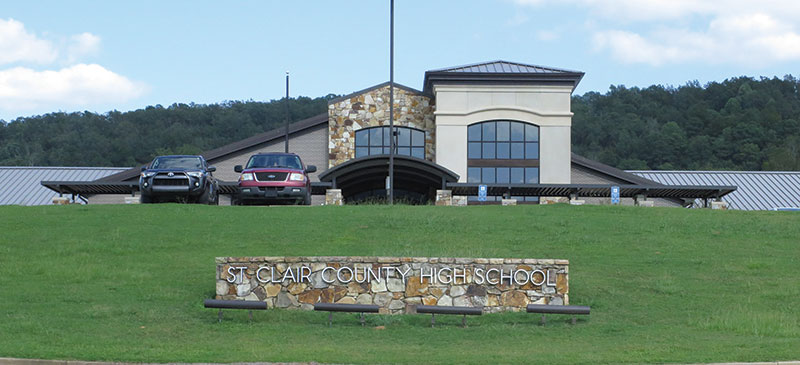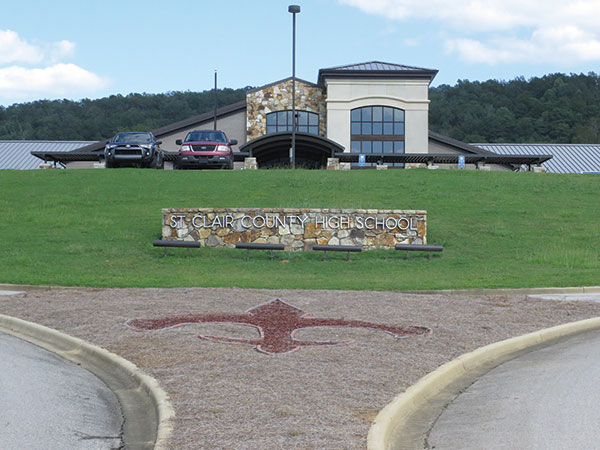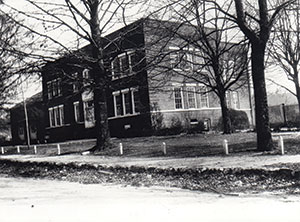

1908 battle for location of county high school lands in Odenville
Story by Joe Whitten
Photos by Graham Hadley
Submitted Photos
When Braxton Bragg Comer was elected governor in 1906, among his goals was upgrading Alabama schools. In 1907, legislation passed to establish county high schools in counties where there was not already a state-supported high school — for white students. It would be 60 years before integration of schools in the county.
Most of St. Clair County was excited about a state-accredited high school being established in one of its towns. Location committees were appointed by the state to review the towns and their resources.
A review of local newspapers of the day shows that Pell City, Odenville and Springville wanted the school. Ashville was not interested, and their newspaper, The Southern Aegis, consistently at odds with Gov. Comer, commented in its Feb. 26, 1908, issue that it seemed Comer was “… making a vigorous campaign for his future aspirations” and that “… he is taking advantage of the high school appropriation at the public expense.” The writer concluded, “He may fool some people all the time, but not all the people every time.”
Odenville published a newspaper, The St. Clair County News, and its editor, J.L. Maddox, set to work composing florid prose in praise of his town. Pell City had no paper, but was in the process of establishing The Pell City Progress, but it would not come into production until March 1908. So, it was Odenville’s newspaper that announced in February that the Governor’s Location Committee would come to Odenville on Saturday, March 7.
Location, location, location
An Odenville editorial of March 5 boasted reasons why Odenville was the perfect location for a state high school. It had:
- A central location.
- A prosperous agricultural community.
- Sixteen wells in the area.
- Ideally suited with good public roads leading to all areas of the county.
- On the Seaboard Airline railroad (making it convenient for boarding students).
Maddox’s final point was that “Pell City has every advantage for cotton mills, but nature never intended it to be an educational site for the St. Clair County High School” — an incautious observation that could not go unnoticed by Pell City.
The date arrived for the governor and his Location Committee’s visit, and the day dawned clear and bright. Folks began trickling into Odenville before seven o’clock. By 9:30 the crowd was reported to be “a multitude,” for a special train had picked up and delivered citizens from Ragland, Coal City and Pell City. The papers estimated the day’s crowd to be between 2,500 and 3,000.
The meeting with the governor and committee took place at the elementary school in Odenville. Watt Brown of Ragland made a talk expressing his faith in Odenville’s future. Brown’s Odenville Land and Development Company had laid out Odenville’s town limits in a circle with a 1-mile radius from the center of the bridge over Beaver Creek on today’s Third Avenue. As a businessman dealing in real estate, Brown would not have been investing in the town had he not believed he would get a good return on his money.
After a lunch with Dr. and Mrs. C.C. Brown, the governor and committee journeyed to Pell City to hear their presentation of Pell City as the better location for the new high school.
Governor Comer’s comments to Pell City were not recorded in print, but it is clear that Pell City was offended by Comer’s observations.
On April 23, under the headline, “What’s Sharper than a Serpent’s Tooth?,” the Progress reported its assessment of the governor’s attitude.
Pell City had presented their town and the Coosa Valley area as the logical choice for St. Clair County High School. Their stated points were:
- 30 percent of the county’s voters lived within 5 miles of Pell City.
- 40 percent of the county’s cotton grew in Coosa Valley.
- 30 percent of the cotton was ginned here.
- 50 percent of the county’s industrial wage was paid there.
They offered these facts to the governor and committee “… to fortify the figures of the county superintendent of education that over 30 percent of the county white school children lived within this same area.” Pell City saw these figures as logical reasons why Pell City was a better location than Odenville for St. Clair County High School.
The Progress observed that “Mr. Comer did not accept the argument” as presented. Rather, “He took it as proving that we were selfish in the Coosa Valley, that we had no concept of what this high school was to be, and that we were making political threats.”
The editor continued, “If it so happens that Mr. Comer himself believes in his accusations, we wish, taking advantage of the last word, to enlighten him.
“The Coosa Valley is not selfish, howsoever much individuals may say. The Coosa Valley does know what a High School is, and she knows it well enough to welcome every child who comes to it. … A High School is not a boarding school, [for] the large majority of its pupils will come from that territory within which the boys and girls may attend school and eat both breakfast and supper at home. … Pell City has more school children than Springville, Ashville and Odenville combined. … On the principle that Mahomet went to the mountain, Pell City claims the school and so here endeth the last word.”
And the winner is …
Having presented their best, Odenville and Pell City entered a busy waiting period as they anticipated the state’s decision. It was the county high school, and the state expected the entire county’s financial help with construction, therefore towns formed committees to collect pledges and funds.
 In April, Progress reported that folks in Ashville and Springville claimed “inside information,” and were of the opinion Pell City had “no chance” of being selected. But rather than losing heart, Pell City published that they had “the best chance” based upon the facts submitted in connection with the state’s proposal for location.
In April, Progress reported that folks in Ashville and Springville claimed “inside information,” and were of the opinion Pell City had “no chance” of being selected. But rather than losing heart, Pell City published that they had “the best chance” based upon the facts submitted in connection with the state’s proposal for location.
In hopes of winning, they continued collecting funds.
Then on Friday, May 1, 1908, the state announced Odenville as winner of St. Clair County High School. Whereupon, the town fathers set about to accomplish the awarded task —constructing a high school building.
Pell City Progress reported their loss in the May 7 issue, saying their loss showed “what comes from organized effort and what can be lost for lack of it.” They offered this opinion: “It is feared that our friends at Odenville have bitten off more than they can chew with comfort.” Then, perhaps still chaffing over Odenville’s “mill town” assessment, Tilton prophesied that the state would come to regret having “put a ten-thousand-dollar school building in a one-thousand-dollar town.”
With that parting zinger, Pell City turned her singular attention toward establishing their own high school and having it ready for occupation by September. The chairman of the Pell City school committee, McLane Tilton, announced in the Progress that “Coosa Valley may rest assured that a High School is going to be located at Pell City, and accomplished with or without the help of the state.” Tilton announced that “Donations to the [county] High School are hereby declared void.” Anyone wanting signed pledges returned should call at the Bank of St. Clair County (became Union State Bank in 1918), where he served as president, before May 15. After that date, notes would be destroyed. Tilton expressed faith that the town could raise “not less than four thousand dollars” to build a high school and that Pell City would “have the satisfaction of owning our own school, built and maintained by ourselves.”
In Odenville, Mr. and Mrs. John Newton, Mr. and Mrs. W.C. Hardin, and Watt Brown had donated land for the school. Now, the school committee set about collecting funds and redeeming pledges. This proved to be a slow process, for some outside Odenville were not forthcoming on pledges. However, one elderly woman, Nancy Turrentine, deeded 20 acres of her farm to the new high school. The Odenville paper noted that she offered to give 20 more if they were needed to raise the required amount.
On Saturday, July 18, 1908, Judge John W. Inzer laid the cornerston for St. Clair County High School. The St. Clair County News reported that “a crowd” from across the county was present for the event. Watt Brown was master of ceremonies. Gov. Comer and other state dignitaries made speeches. Judge Inzer, in laying the cornerstone, expressed his hope that wounded feelings would be laid aside and that every community would “stand united to advance the interest of our county.”
In the fall of 1908, the high school met in the Odenville Elementary School, for a new building would take months to construct. But despite setbacks and delays, in 1909, St. Clair County High School would occupy a two-story brick building.
The citizens of Pell City also coalesced to establish a high school. On May 7, 1908, the editor of the Progress reported that “the Town of Pell City has two thousand dollars which it contributed to the [County] High School fund and now goes back into the [Pell City] treasure.” Tilton suggested that the money should be used for the construction of the Pell City High School, which he speculated would cost about $3,000.
To spur on the town and surrounding area, he wrote, “The same arguments used to locate the County School here now demand of us that we show what we can do alone and unassisted.” The editor issued a trumpet call by saying, “Progress demands of the Council and School Board to hold a called meeting,” and concludes that city fathers could “… create a public sentiment that will result in the action desired without delay. … We must have this school by September 1st.”
The City Council and School Board accepted the call, met together, and in the June 4, Progress could report that “The Council and School Board each appropriated one thousand dollars” and that the “two thousand in all…will be at once utilized to build the high school addition to our present building.”
As the months progressed, meetings, suggestions and decisions were regularly reported in the newspaper. Just as in Odenville, there were setbacks and delays, but a Pell City High School was assured. An Aug. 13 article reports: “The new addition to the school is rapidly nearing completion and will be ready by the first day of the term. This addition will cost in the neighborhood of $3,500, including furnishings, and will give us a ten-thousand-dollar modern structure second to none in the State.”
The new addition would add four rooms and an auditorium “fitted out with orchestra chairs.” The auditorium would “hold about 400,” and the stage would have dressing rooms and be “electric lighted.”
Exciting days! For the completion of the brick addition with a metal roof would give “… Pell City and south St. Clair a primary and high school sufficient for our needs for several years to come.”
Thus, Pell City High School was born, and the Progress’ headline on Sept. 17 proclaimed: “OUR SCHOOL BEGINS,” noting, “The high school is open to all the children of the county, several having already entered from Seddon and Eden.”
A win-win situation
As years have waxed and waned since 1908, student numbers have increased in each school, validating the work of both towns over 100 years ago. In the 2016 school year, St. Clair County High School served 587 students, and Pell City High School, 1,105 students.
Most of the time, battles end with only one winner. In the battle for the location of St. Clair County High School, both Odenville and Pell City won. The loss of the county high school proved to be the impetus needed for Pell City to organize its own high school. Pell City High School and St. Clair County High School today cherish the past, yet each looks to the future and the challenges of their second century.















